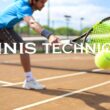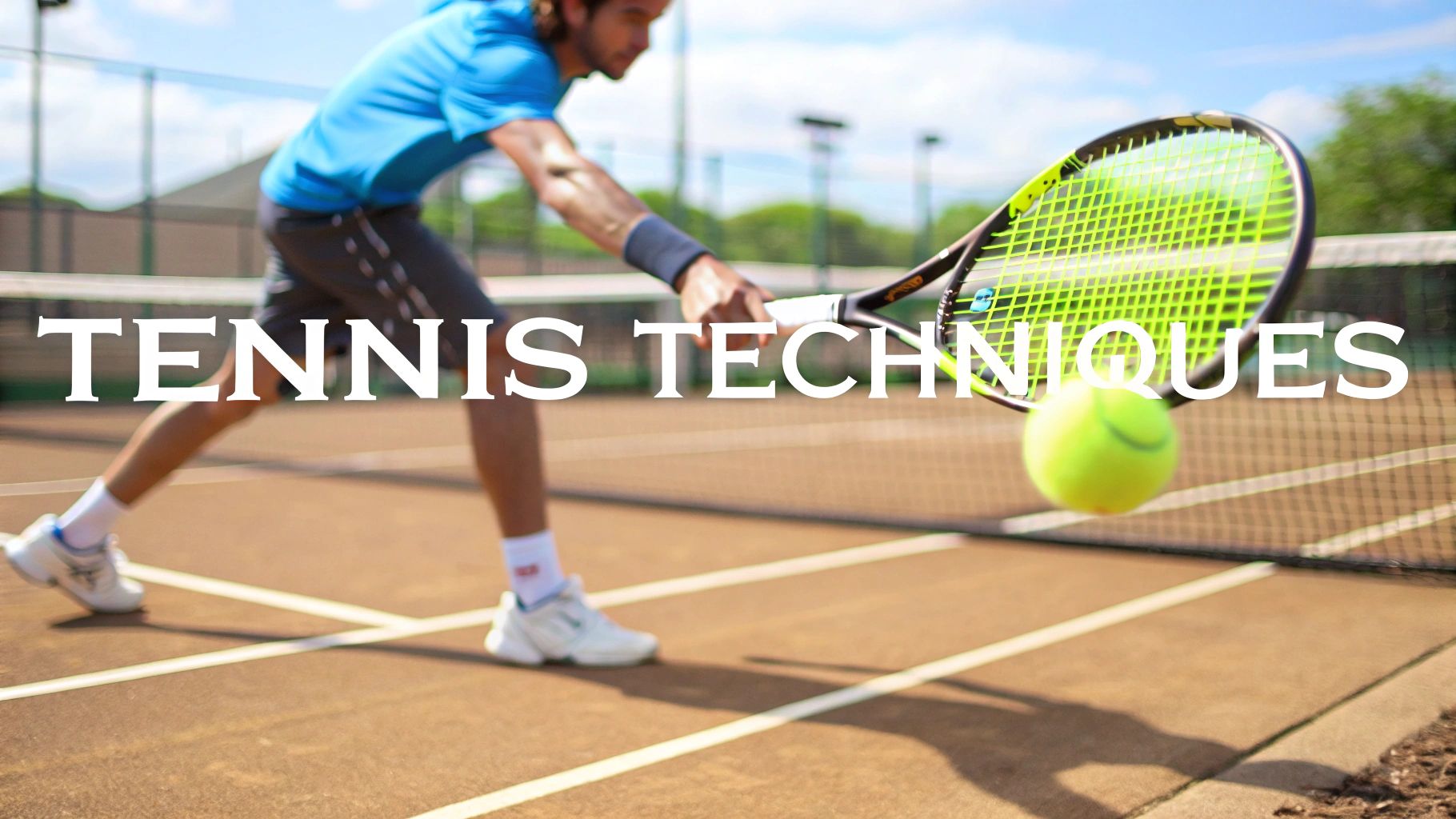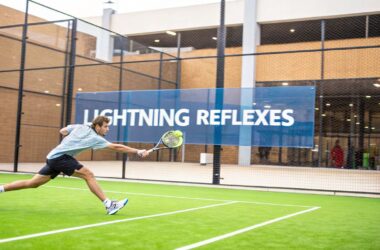If you want to move from just getting the ball over the net to actually winning points, you have to start with the fundamentals. And in tennis, it all comes down to your grip and your stance. How you hold the racquet and position your feet is the foundation for every single shot you'll ever hit—it's what gives you power, control, and the ability to adapt.
The Foundation of Every Shot: Grips and Stances
Before you even think about hitting a blistering forehand or a pinpoint serve, you have to nail what happens before the swing. Your connection to the racquet (the grip) and your connection to the court (the stance) are the two pillars holding up your entire game.
This isn't just for beginners, either. Pros are constantly tweaking and refining these elements.
Think of your grip as choosing the right tool for the job. Each one serves a specific purpose. For example, the Continental grip is often called the "jack-of-all-trades." It’s perfect for serves, volleys, and defensive slices because its neutral position lets you make quick adjustments, especially when you're up at the net.

Buy the best padel gear to level up your next game!
CHECK OUT this deal from Padel Market!Get ready to take your game to the next level with the latest padel gear from Padel Market! Fast EU and Worldwide Shipping
But when you're hanging back at the baseline and want to rip a groundstroke with heavy topspin, that's when you'll see players shift to a Semi-Western or Western grip. These "closed face" grips naturally help you brush up the back of the ball, creating those high-arcing, heavy shots that are so dominant in modern tennis.
Choosing Your Stance for the Situation
Your stance is your launching pad. The right footwork sets you up with balance and power, preparing you to either attack a short ball or dig out a deep, defensive one. You'll find yourself using three main stances over and over during a match.
This infographic breaks down the three core stances and shows you exactly when to use each one.
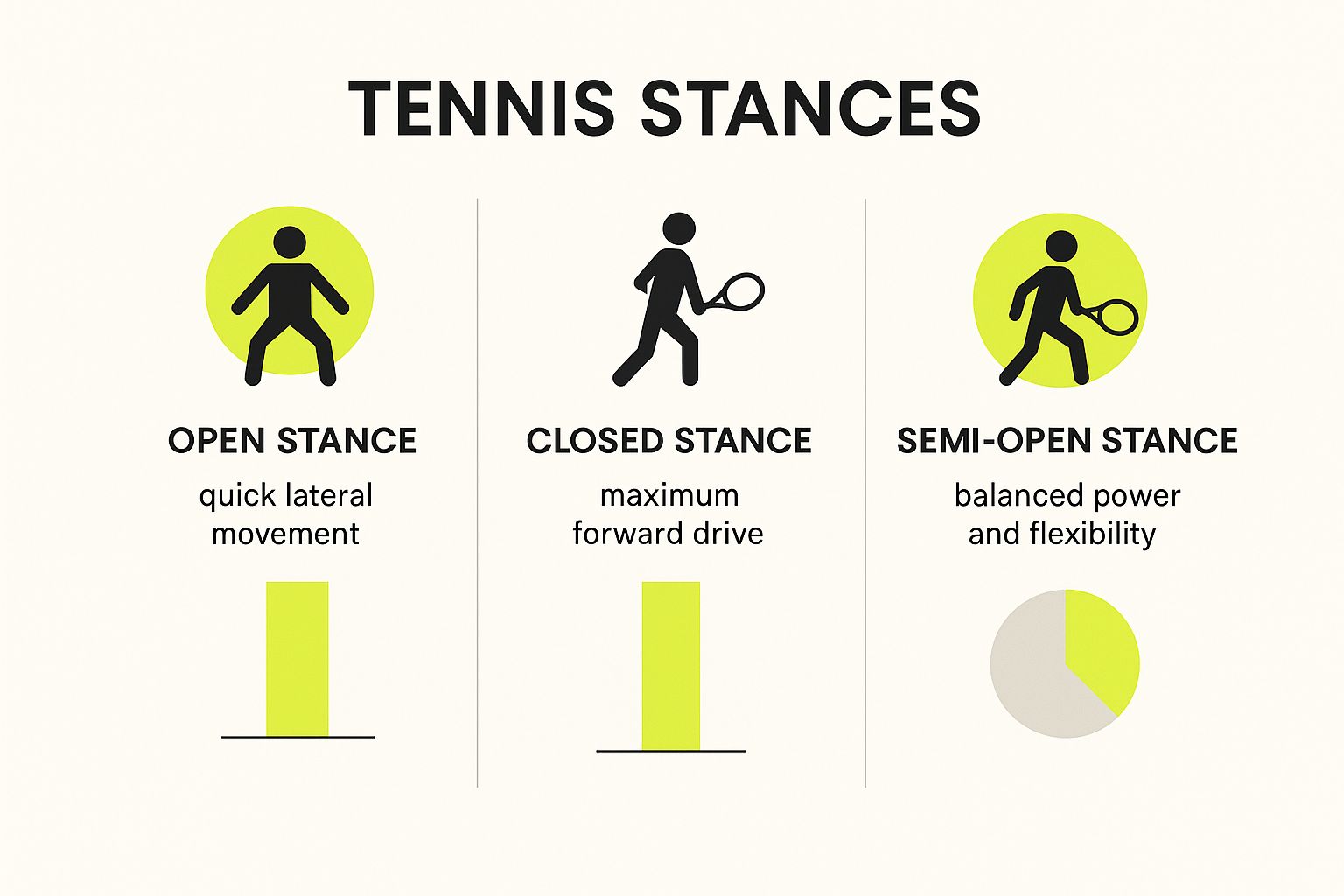
As you can see, there are clear trade-offs. The Open Stance is fantastic for quick recovery, the Closed Stance gives you maximum power transfer, and the Semi-Open offers a versatile sweet spot in between.
The biggest mistake I see players make is getting stuck in one stance. Great players are constantly flowing between open, closed, and semi-open stances based on where they are on the court and what kind of shot is coming at them.
This focus on technique has come a long way. Tennis has evolved dramatically from its origins in the 12th century as a French game called 'jeu de paume' (where they literally used their hands!).
The introduction of racquets in the 16th century was a game-changer, and by 1874, the sport was formalized with rules that still shape how we play today. The equipment has changed just as much, with heavy wooden racquets giving way to lightweight carbon fiber composites. This shift alone has allowed players to generate incredible racquet head speed and shot precision that was once unimaginable. You can dive deeper into this fascinating evolution by reading the American Tennis Association's look at tennis development.
Building Consistent and Powerful Groundstrokes
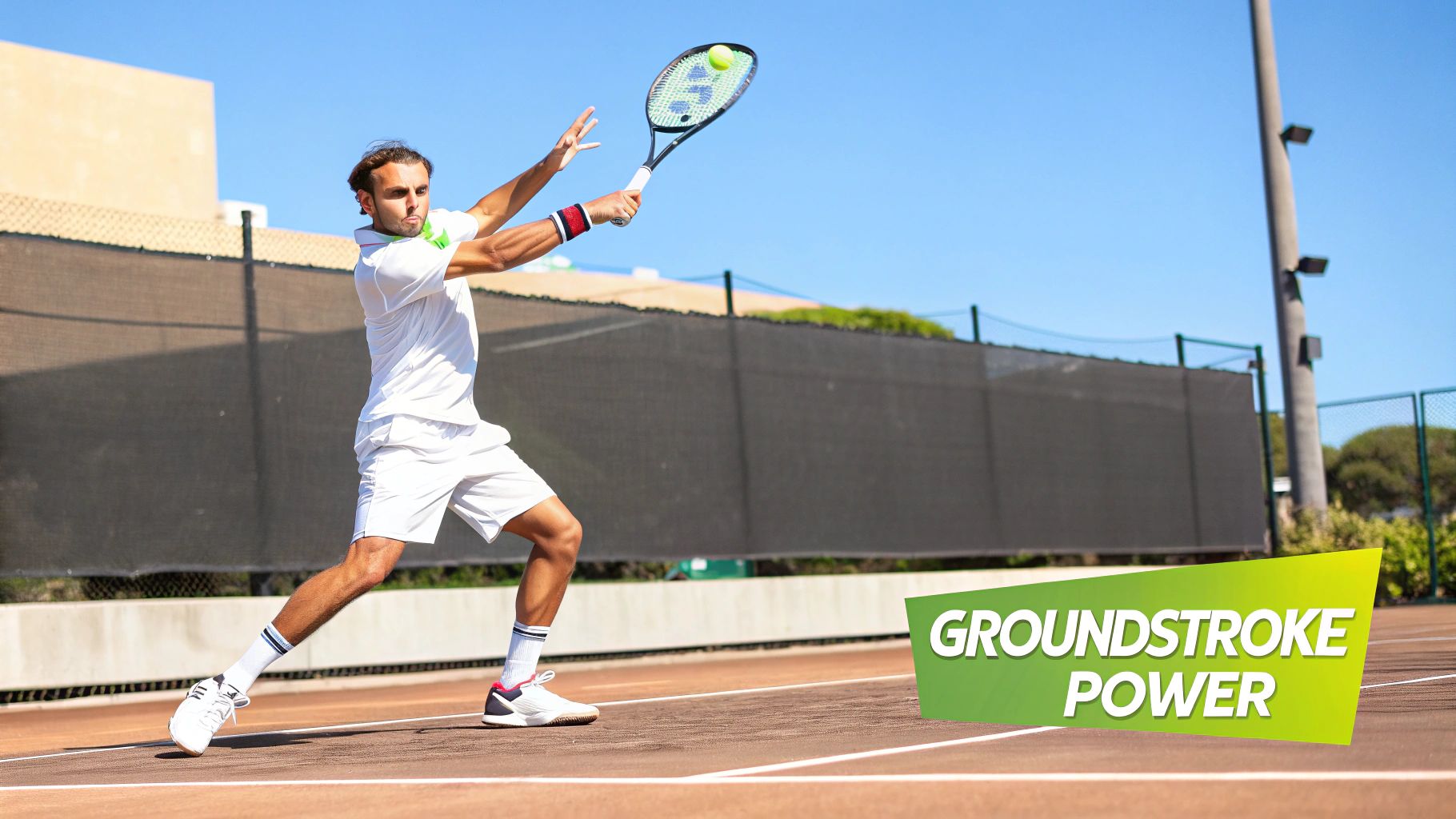
You don't win long, grinding rallies with flashy, one-off winners. Those points are won with rock-solid groundstrokes. Having a dependable forehand and backhand is the foundation of any strong baseline game, giving you the tools to control the point and make your opponent dance to your tune.
Forget trying to muscle the ball. Real power comes from an efficient kinetic chain. True pace starts from the ground up—it travels from your legs, rotates through your hips and torso, and finally explodes through the racquet.
Think of your body as a coiled spring. When you prepare for a forehand, you load up that energy by turning your hips and shoulders away from the incoming ball. The swing is simply the uncoiling, where your hips fire first, pulling your arm and racquet through the hitting zone with incredible speed.
The Role of Topspin in Modern Tennis
If there's one secret ingredient for groundstroke consistency, it's topspin. That beautiful forward rotation on the ball is what allows you to swing out aggressively and still have the ball dive back into the court. It gives you a much bigger target and a greater margin for error.
This technique completely reshaped the modern game, especially starting in the 1970s. As heavy wooden racquets gave way to lighter, more powerful frames, generating heavy spin became much easier. It’s no coincidence that the best players are topspin masters.
Stroke analysis has shown that players who effectively use topspin can slash their unforced error rate by around 15% on aggressive shots compared to players hitting flat. That’s a massive strategic advantage from the baseline. If you're looking to add this to your game, it's a great idea to unlock your best tennis forehand technique.
Comparing Backhand Techniques
When it comes to the backhand, you’ve basically got two choices: one-handed or two-handed. There’s no single "better" option; they just offer different advantages and demand different mechanics. Deciding which one is right for you often comes down to comfort, strength, and what you want to achieve on the court.

Buy the best padel gear to level up your next game!
CHECK OUT this deal from Padel Market!Get ready to take your game to the next level with the latest padel gear from Padel Market! Fast EU and Worldwide Shipping
One-Handed vs Two-Handed Backhand Comparison
This table breaks down the key differences to help you see which style might fit your game.
| Attribute | One-Handed Backhand | Two-Handed Backhand |
|---|---|---|
| Reach | Offers significantly greater reach, especially for wide balls or defensive slices. | More compact, with a shorter reach that requires better footwork. |
| Power | Generates pace from a longer, more fluid swing path and shoulder rotation. | Derives power from a more stable, compact rotation with support from both arms. |
| Stability | Less stable against heavy, high-bouncing balls due to single-arm contact. | Extremely stable on contact, making it easier to handle pace and high balls. |
| Slice | The natural grip and motion make hitting an effective slice much easier and more intuitive. | Can be more awkward to transition to a slice, often requiring the player to release one hand. |
The choice really boils down to personal feel and playing style. We've seen the pure elegance and versatility of the one-hander from legends like Roger Federer, but we've also witnessed the relentless consistency and raw power of the two-hander from Novak Djokovic. Try both and see what clicks.
Your contact point is the moment of truth in any groundstroke. Aim to meet the ball out in front of your body, around waist height. Hitting the ball late forces a defensive, weak shot, while contacting it in front allows you to transfer your body weight forward and through the ball for maximum power and control.
Ultimately, mastering your groundstrokes takes hitting thousands and thousands of balls to build that crucial muscle memory. Focus your practice on drills that force a consistent contact point and a fluid, rotational swing. This repetition also sharpens your ball-tracking skills, a critical component you can learn more about in our guide on how to improve hand-eye coordination.
Developing Your Serve into a True Weapon
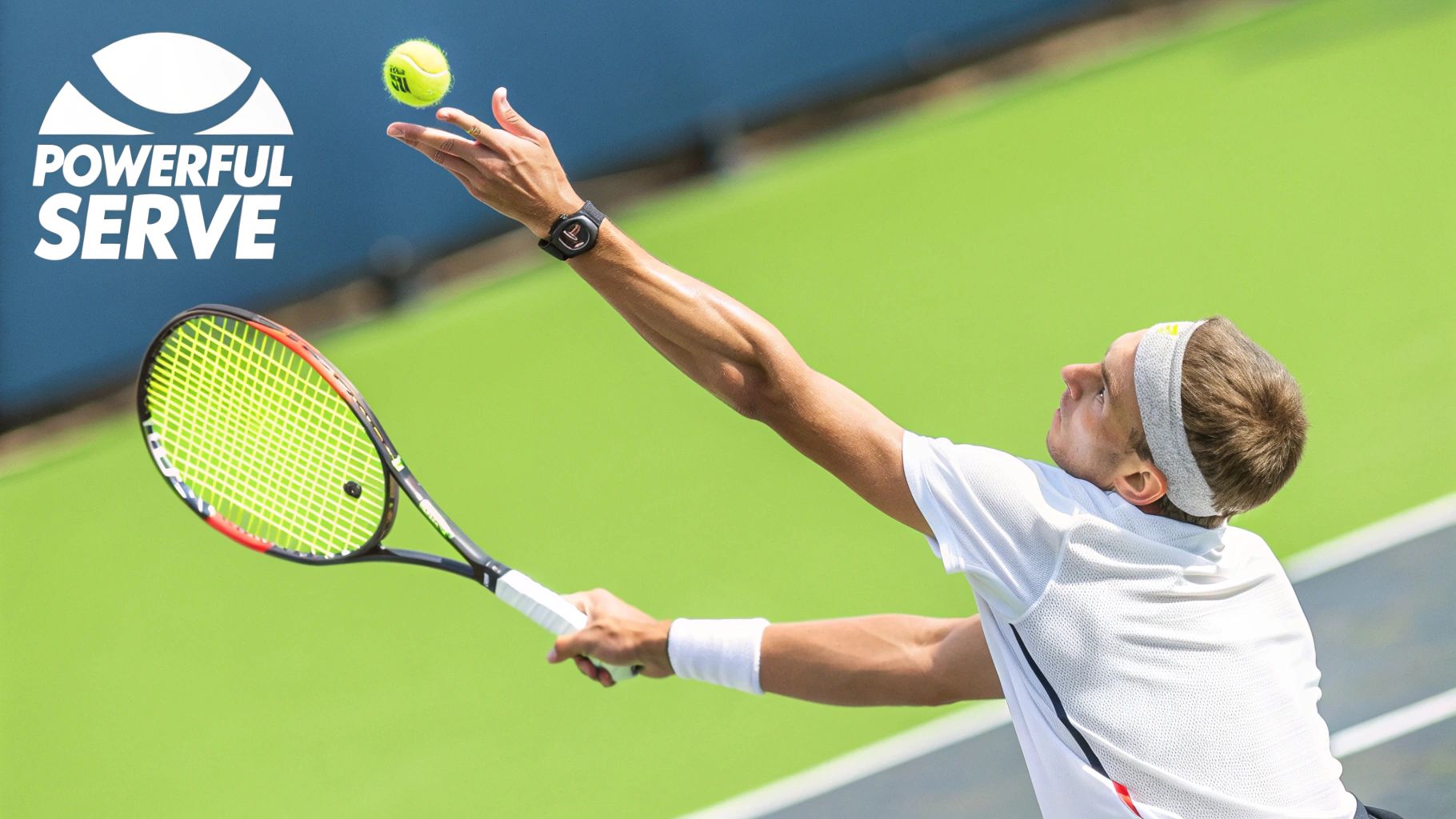
The serve is the one shot in tennis where you call all the shots. You're in complete control of the setup, the timing, and the execution. It’s your chance to start every point on your terms, and turning it into a genuine weapon is one of the absolute fastest ways to level up your entire game.
But a great serve isn't just about swinging for the fences. It's a delicate dance of rhythm, timing, and pure strategy.
It all starts with the ball toss. I can't stress this enough—the toss is the most critical, and often the most frustrating, piece of the puzzle. An erratic toss throws your whole motion out of whack, forcing your body into awkward, last-second adjustments that absolutely kill your power and accuracy.
Your mission is to develop a toss that consistently lands in the same ideal spot, every single time. For a righty, this is usually slightly in front of your body and a bit to the right, putting you in the perfect position to hit up and into the court. A fantastic drill? Forget about swinging. Just place your racquet on the ground where you want the ball to land and practice tossing until you can get it to bounce right on the strings.
Unlocking Power and Spin
Once you’ve got the toss dialed in, it’s time to think about the kinetic chain. Just like your groundstrokes, the real power behind your serve comes from the ground up—from your legs. By bending your knees and then exploding upward into the ball, you generate a massive wave of momentum that travels right up through your body and into the racquet.
This is where your wrist gets involved, specifically through pronation. The best way to picture it is like throwing a football. As your racquet makes contact with the ball, your forearm and wrist naturally rotate inward. That’s the "snap" that generates blistering pace on a flat serve and that wicked break on a slice.
So many players make the mistake of trying to "muscle" the serve using just their arm. Instead, the goal should be a relaxed, fluid motion. The speed should feel like it comes from a whip, not a forceful shove. A loose grip is your best friend here.
Just look at how the pros have evolved. Service speeds in the men’s game have jumped from averages around 160 km/h (100 mph) back in the 70s to well over 210 km/h (130 mph) today. That's a huge leap, and it's all thanks to improved biomechanics.
Choosing the Right Serve
Having a variety of serves in your arsenal adds a whole new strategic dimension to your game, keeping your opponent totally off-balance. Each serve has a unique job, and it’s all about where you strike the ball.
- Flat Serve: This is your knockout punch. You're hitting the back of the ball square-on with minimal spin for pure, unadulterated speed. This is your go-to on a first serve when you're hunting for an ace or trying to force a weak, panicked return.
- Slice Serve: Here, you're brushing the side of the ball (think 3-to-9 o'clock). This creates sidespin that makes the ball curve wide and skid low after the bounce, dragging your opponent way off the court and opening things up for your next shot.
- Kick Serve: This one is all about heavy topspin. By striking the ball on an upward path (from about 7-to-1 o'clock), you make it jump up high and away from your opponent after the bounce. It’s an incredibly effective and safe second serve that’s tough to attack.
Turning your serve into a weapon takes hours of physical repetition, but don't forget the mental side. Staying calm and focused when the pressure is on is just as important. For a deeper dive into that side of the game, take a look at these sports psychology techniques.
How to Command the Net with Volleys and Overheads
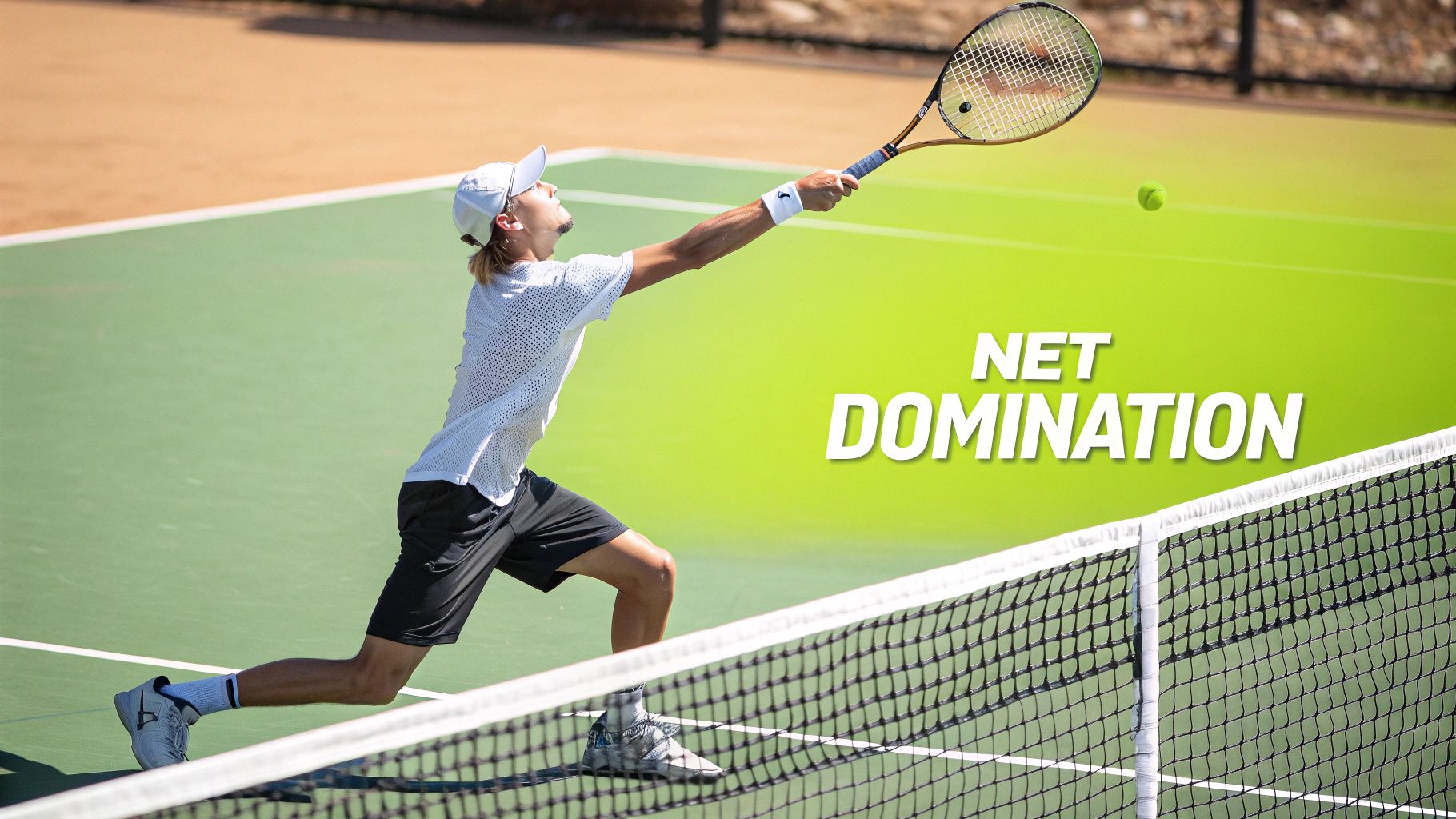
If baseline rallies are about patience, the net game is all about aggression and quick reflexes. This is where you finish points. By moving forward, you take precious time away from your opponent, cutting off their angles and turning a 50/50 rally into a point-winning attack.
The single biggest mistake I see club players make with volleys is taking a huge, loopy swing like they're hitting a groundstroke. Forget that. A volley isn't a swing; it’s a punch.
Your motion needs to be short, compact, and firm. You’re not trying to create your own power here. Instead, think of it as blocking the ball and simply redirecting its existing pace. Keep that racquet head up and out in front of your body, always ready to react, and stick with a Continental grip for maximum versatility.
Mastering Volley Mechanics
Whether it’s a forehand or backhand volley, the core mechanics are surprisingly similar. You’ll always start with a split-step the moment your opponent strikes the ball, which gets you ready to spring toward the incoming shot.
- The Forehand Volley: For right-handers, step forward with your left foot. This gets your body behind the shot. Keep the racquet face just slightly open and punch firmly through the ball, aiming for an open part of the court.
- The Backhand Volley: The motion is almost the same, but this time you’ll step across your body with your right foot to create a stable base. Honestly, many players find the backhand volley feels more natural and solid because it’s a pure blocking motion.
But what happens when the ball is hit right at your body? The classic "jam." Don't freeze up. The quickest and most controlled response is to simply pivot your shoulders to one side and play it as a backhand volley.
This aggressive, all-court style used to be the cornerstone of the game. The serve-and-volley tactic dominated pro tennis for decades, especially on slick grass courts where points were over in a flash. It's estimated that during the mid-20th century, up to 60% of Wimbledon champions were masters of this exact technique. You can learn more about the evolution of tennis technique to see how the game has changed.
Conquering the Overhead Smash
The overhead is your exclamation point—a chance to end the rally with total authority. When your opponent tosses up a desperate lob, your job isn't just to return it; it's to put it away for good.
Positioning is everything. The second you read the lob, turn your body sideways and start moving back using shuffle steps or crossover steps. A great tip is to point at the ball with your non-hitting hand, which helps with balance and tracking.
The overhead motion is basically a serve. You want to reach up high and make contact with the ball at its absolute peak. Then, snap your wrist downward to direct the ball with pace into the open court. Whatever you do, don't let it drop.
By building solid volleys and a confident overhead, you stop being a one-dimensional baseliner. You become an all-court threat who dictates the terms of engagement and decides how points are won.
Mastering Footwork for Better Court Coverage
https://www.youtube.com/embed/YulpiQpSkmU
You can have the most devastating serve or a killer forehand, but none of it matters if you can't get to the ball. Think of footwork as the unsung hero of your tennis game—it's the invisible thread connecting every shot, turning what could be frantic scrambling into efficient, powerful movement. It's what keeps you balanced and ready for whatever your opponent throws at you.
The absolute cornerstone of good footwork, and something I see players neglect all the time, is the split-step. It's not some fancy, complicated maneuver. It's just a light hop you take the very instant your opponent makes contact with the ball.
This simple bounce lands you on the balls of your feet in a wide, athletic stance. You're now a loaded spring, ready to explode in any direction—left, right, forward, or back. Nailing the timing of your split-step means you are never caught flat-footed. That split second you gain is often the difference between controlling the point and being forced onto the defensive.
Essential Movement Patterns
Once you’ve made that explosive first move from the split-step, your next steps have to be just as efficient. Just sprinting wildly around the court will burn you out and wreck your positioning. Instead, you need to drill the specific movement patterns that are built for the geometry of a tennis court.
There are two patterns you absolutely have to own:
- Shuffle Step: This is your go-to for moving side-to-side along the baseline. You stay square to the net, ready to hit. It’s perfect for cross-court rallies because your feet never cross, allowing you to change direction on a dime.
- Crossover Step: When you need to cover more ground fast—chasing down a wide ball or rushing the net for a drop shot—this is your move. The outside leg crosses over the inside one, generating serious momentum to get you where you need to be.
Good footwork isn't just about raw speed. It's about anticipation and economy of motion. The real goal is to get to the ball early enough that you can plant your feet, stay balanced, and hit a controlled, powerful shot. You want to move to the ball, not just run past it.
Drills to Sharpen Your Agility
Getting better here means training your feet to be quick, light, and responsive. The fastest way to build this muscle memory is by incorporating specific drills into your practice. You'd be amazed what simple exercises with an agility ladder or a few cones can do for your court coverage.
To take it a step further, it's smart to include general athletic training to improve your running speed and form. A solid fitness base translates directly to better performance on the court. For a more structured plan, I highly recommend checking out these incredibly effective agility and speed drills. Mastering these movements will ensure you're not just chasing balls, but arriving in the perfect position to win the point.
Frequently Asked Questions About Tennis Technique
Learning proper tennis technique can feel like putting together a complex puzzle.## Common Questions About Tennis Techniques
Developing solid technique in tennis often feels like solving a puzzle, where one small adjustment can suddenly make everything click. As you start moving past the beginner stage, certain questions pop up time and time again. Getting these answers is the key to breaking through those frustrating plateaus.
One of the biggest hurdles players face is breaking a long-standing bad habit. Maybe it’s a buggy forehand swing you picked up years ago, or a serve toss that goes haywire under pressure. The thought of fixing it can feel overwhelming, but the secret often starts with exaggeration.
Let's say you're dropping your racquet head on your backhand. To fix it, you need to practice a takeback that feels ridiculously high. It’s going to feel completely unnatural at first, but that overcorrection is exactly what you need to retrain your muscle memory. This is where shadow-swinging in front of a mirror or recording yourself is pure gold—you get that instant visual feedback to see what's really happening.
How Long Does It Realistically Take to Improve?
This is the big one. Everyone wants to know the timeline for improvement. It’s natural to want to see results yesterday, but mastering tennis techniques is a marathon, not a sprint. There's no magic number, but you'll see progress come in phases.
You might spend a few weeks drilling a specific change, like a new grip, and feel like you're actually getting worse. Don't panic. This is a totally normal part of the process. Your old, comfortable habit is at war with the new, correct one.
The key is consistent, focused practice. Just hitting balls for two hours without a goal won't move the needle much. But 20 minutes of dedicated practice on a single element—like keeping your head still through contact—can produce real results much, much faster.
To make a new technique feel like second nature, you're realistically looking at several months of consistent play, ideally 2-3 times per week.
Which Technique Should I Choose?
From the classic one-handed vs. two-handed backhand debate to choosing between a slice or kick serve, players often get stuck wondering which technique is "best." The truth? There’s no single right answer. The perfect choice comes down to your own physical build and how you like to play the game.
Let’s break down the backhand, for instance:
- The Two-Handed Backhand: This is your go-to for stability and power. It makes handling high-bouncing balls and returning powerful serves much easier. If you're an aggressive baseliner, this is probably your shot.
- The One-Handed Backhand: This offers more reach and a ton of versatility, especially for carving up slices. Players who love an all-court game and thrive on strategic variety often gravitate toward the one-hander.
Instead of chasing the "correct" technique, focus on what feels most natural and effective for you. Spend some time in practice experimenting with different options. The shot that gives you the most confidence and consistency is the right one for your game, period.
The same logic applies to your serve. Don't try to master every spin at once. Start by building a reliable first serve (like a flat or slice) and a safe second serve (like a kick) that you can count on. Trying to perfect everything from the get-go just leads to confusion and frustration, and it will stall your overall progress on the court.


